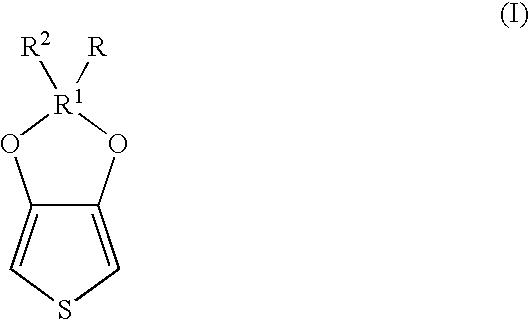Polythiophenes
a technology of polythiophene and polythiophene, which is applied in the direction of non-metal conductors, conductors, dyeing processes, etc., can solve the problems of oxidants only being removed, unable to obtain anhydrous or low-water-content solutions or dispersions in this way, and afflicted with difficulties and disadvantages
- Summary
- Abstract
- Description
- Claims
- Application Information
AI Technical Summary
Benefits of technology
Problems solved by technology
Method used
Image
Examples
example 1
Preparation of an Ethanolic Polystyrenesulfonic Acid Solution
[0048]400 ml of an aqueous solution of a polystyrenesulfonic acid having a molecular weight (Mw) of about 70,000 were evaporated to dryness and dissolved in 1000 ml of ethanol. The solids content of the solution was found to be 10.4% by weight.
example 2
Preparation of a Polythiophene According to the Invention in the Form of a Solution
[0049]133 ml of ethanol, 14.77 g (0.0256 mol) of iron(III) toluenesulfonate, 1399.76 g of the polystyrenesulfonic acid solution from Example 1, 3.7 g (0.014 mol) of 18-crown-6, 74.66 g (0.2765 mol) of potassium peroxodisulfate and 27.97 g (0.1967 mol) of 3,4-ethylenedioxythiophene were combined in a reactor and homogenized for 1 minute using a commercially available disperser (Ultra-Turrax® from IKA). A finely divided suspension was formed. The suspension was subsequently stirred at room temperature for 24 hours. The reactor contents became a dark-blue color during the reaction time. The reaction conversion was found to be 95.1% by analysis by gas chromatography.
example 3
Purification of a Polythiophene According to the Invention
[0050]The solution from Example 2 was filtered, 455 ml of cation exchanger (Lewatit® S 100, a strongly acidic ion exchanger containing sulfonate groups based on crosslinked polystyrene, commercial product from Bayer AG, Leverkusen) and 525 ml of anion exchanger (Lewatit® MP 62, a basic ion exchanger containing tertiary amino groups based on crosslinked polystyrene, commercial product from Bayer AG, Leverkusen) were added, and the mixture was stirred for 1 hour and filtered. A dark-blue, clear solution was obtained. A sample of this solution was diluted with ethanol to a solids content of 0.4% by weight, and a coating with a thickness of 60 μm was applied from the dilute solution to a plastic film (polyethylene terephthalate) with the aid of a hand coater and dried at 80° C. for 15 minutes. The thickness of the dry coating was about 240 nm. The surface resistance of the applied layer was 7 Mohm / square in accordance with IEC st...
PUM
| Property | Measurement | Unit |
|---|---|---|
| temperature | aaaaa | aaaaa |
| temperatures | aaaaa | aaaaa |
| temperature | aaaaa | aaaaa |
Abstract
Description
Claims
Application Information
 Login to View More
Login to View More - R&D
- Intellectual Property
- Life Sciences
- Materials
- Tech Scout
- Unparalleled Data Quality
- Higher Quality Content
- 60% Fewer Hallucinations
Browse by: Latest US Patents, China's latest patents, Technical Efficacy Thesaurus, Application Domain, Technology Topic, Popular Technical Reports.
© 2025 PatSnap. All rights reserved.Legal|Privacy policy|Modern Slavery Act Transparency Statement|Sitemap|About US| Contact US: help@patsnap.com



